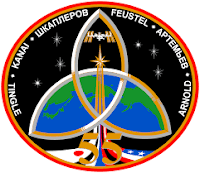ISS - Expedition 55 Mission patch.
May 11, 2018
This week, the crew members aboard the International Space Station continued scientific operations and spacewalk preparation as tons of science and hardware returned to Earth aboard the SpaceX Dragon capsule on Saturday, May 5.
International Space Station (ISS). Image Credit: NASA
NASA astronauts Ricky Arnold and Drew Feustel will conduct the 210th spacewalk at the space station beginning Wednesday, May 16. The veteran spacewalkers will work to swap thermal control gear that controls the circulation of ammonia to keep external station systems cool. NASA TV begins its live coverage at 6:30 a.m.
Here is a look at some of the science that happened this week aboard your orbiting laboratory:
Crew member examines blood vessels and heart
Cardiac and Vessel Structure and Function with Long-Duration Space Flight and Recovery (Vascular Echo) examines changes in blood vessels and the heart, both in space and on Earth. The results may provide insight into potential countermeasures to help maintain crewmember health, and quality of life for those on Earth.
Animation above: NASA astronaut Scott Tingle works within the CIR as a part of the ACME E-FIELD Flames investigation. Animation Credit: NASA.
This week, a crewmember attached Electrocardiogram (ECG) electrodes to himself, marked his femoral artery and then performed an ultrasound scan with remote guidance from the ground team.
Imagery contributes to study of Intracranial Pressure
The Non-invasive Assessment of Intracranial Pressure for Spaceflight and Related Visual Impairment (IPVI) investigation studies changes to crewmembers’ eyes and optic nerves by analyzing arterial blood pressure and blood flow to the brain before and after spaceflight. This investigation uses non-invasive methods to measure intracranial pressure, rather than commonly used more invasive methods.
Image above: The SpaceX Dragon capsule, pictured above, returned to Earth Saturday full of science and hardware. Image Credit: NASA.
This week, a crewmember took front and side photographs to check for any facial swelling, followed by a conference with ground experts.
Studying crew culture
The Culture, Values, and Environmental Adaptation in Space (At Home in Space) investigation, sponsored by the Canadian Space Agency, looks at changes in perceptions about home in space and the ways a unique culture may develop aboard the station during a mission.
Animation above: The SpaceX Dragon capsule departs the International Space Station, carrying with it samples and hardware from research conducted aboard the orbiting laboratory. Animation Credit: NASA.
Participants answer a series of questionnaires before, during and after flight, enabling researchers to see whether perceptions and the relative importance of values change over the course of a mission. Questions explore individual and culturally related differences, family functioning and relationships, personal values and coping with stress. This week, a crew member completed the questionnaire prior to his midday meal.
Space to Ground: Ready for a Walk: 05/11/2018
Other work was done on these investigations: Crew Earth Observations, Veggie PONDS, CBEF, CIR, Multi-Use Variable-g platform (MVP), MERLIN, Probiotics, Radi-N2, ELF, Microbial Tracking-2, J-SSOD #8, and Food Acceptability.
Related links:
NASA TV: https://www.nasa.gov/multimedia/nasatv/index.html
Vascular Echo: https://www.nasa.gov/mission_pages/station/research/experiments/explorer/Investigation.html?#id=1664
At Home in Space: https://www.nasa.gov/mission_pages/station/research/at_home_in_space
Crew Earth Observations: https://www.nasa.gov/mission_pages/station/research/experiments/explorer/Investigation.html?#id=84
Veggie PONDS: https://www.nasa.gov/mission_pages/station/research/experiments/explorer/Investigation.html?#id=7581
CBEF: https://www.nasa.gov/mission_pages/station/research/experiments/explorer/Facility.html?#id=333
CIR: https://www.nasa.gov/mission_pages/station/research/experiments/explorer/Facility.html?#id=317
Multi-Use Variable-g platform (MVP): https://www.nasa.gov/mission_pages/station/research/experiments/explorer/Facility.html?#id=1777
MERLIN: https://www.nasa.gov/mission_pages/station/research/experiments/explorer/Facility.html?#id=29
Probiotics: https://www.nasa.gov/mission_pages/station/research/experiments/explorer/Investigation.html?#id=2047
Radi-N2: https://www.nasa.gov/mission_pages/station/research/experiments/explorer/Investigation.html?#id=874
ELF: https://www.nasa.gov/mission_pages/station/research/experiments/explorer/Investigation.html?#id=1738
Microbial Tracking-2: https://www.nasa.gov/mission_pages/station/research/experiments/explorer/Investigation.html?#id=1663
J-SSOD: http://www.nasa.gov/mission_pages/station/research/experiments/explorer/Facility.html?#id=883
Food Acceptability: https://www.nasa.gov/mission_pages/station/research/experiments/explorer/Investigation.html?#id=7562
Spot the Station: https://spotthestation.nasa.gov/
Space Station Research and Technology: https://www.nasa.gov/mission_pages/station/research/index.html
International Space Station (ISS): https://www.nasa.gov/mission_pages/station/main/index.html
Images (mentioned), Animations (mentioned), Video, Text, Credits: NASA/Michael Johnson/Yuri Guinart-Ramirez, Lead Increment Scientist Expeditions 55 & 56.
Best regards, Orbiter.ch





